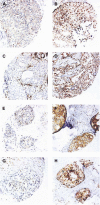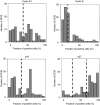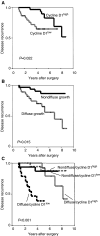Tissue microarray analyses of G1/S-regulatory proteins in ductal carcinoma in situ of the breast indicate that low cyclin D1 is associated with local recurrence
- PMID: 14612904
- PMCID: PMC2394433
- DOI: 10.1038/sj.bjc.6601398
Tissue microarray analyses of G1/S-regulatory proteins in ductal carcinoma in situ of the breast indicate that low cyclin D1 is associated with local recurrence
Abstract
Ductal carcinoma in situ (DCIS) of the breast constitutes about 10% of all diagnosed breast cancers and, despite surgical removal, it may recur, either as DCIS or invasive breast cancer. Nuclear grade and growth pattern according to Andersen et al as well as surgical margins are factors that have been used to predict local recurrence, but ideally a set of tumour-specific factors should be identified and used as prognostic markers. Many cell cycle regulatory gene products have been shown to be involved in the formation of tumours and are either oncogenes or suppressor genes and involved in key processes in the transformation. We therefore characterised the cell cycle regulators cyclin E, cyclin D1, p27 and p16 in a material of DCIS cases arranged in a tissue microarray. With a manual tissue arrayer, 52% of the initial 177 DCIS samples were successfully targeted allowing immunohistochemical analyses of all four proteins in 92 cases of DCIS. As also observed in invasive breast cancer, there was a trend indicating that DCIS cases with high cyclin D1 were cyclin E low and oestrogen receptor-positive, whereas cyclin E high DCIS cases were cyclin D1 low and oestrogen receptor-negative. For the 64 patients that did not receive postoperative radiotherapy, there were 16 local recurrences (eight DCIS and eight invasive breast cancer) during a mean follow-up time of 63 months. Cyclin E, p27 or p16 were not associated with local recurrence, but interestingly cyclin D1 was significantly and inversely associated with local recurrence, both using univariate and multivariate analyses. In summary, using a tissue array approach we have shown that cyclin D1, besides growth pattern, is a prognostic marker for local recurrence in DCIS.
Figures




Similar articles
-
Expression of p21Waf1, p27Kip1 and cyclin D1 proteins in breast ductal carcinoma in situ: Relation with clinicopathologic characteristics and with p53 expression and estrogen receptor status.Pathol Int. 2001 Feb;51(2):94-9. doi: 10.1046/j.1440-1827.2001.01173.x. Pathol Int. 2001. PMID: 11169147
-
Histological type and marker expression of the primary tumour compared with its local recurrence after breast-conserving therapy for ductal carcinoma in situ.Br J Cancer. 2001 Feb;84(4):539-44. doi: 10.1054/bjoc.2000.1618. Br J Cancer. 2001. PMID: 11207051 Free PMC article. Clinical Trial.
-
S100A7 (psoriasin) expression is associated with aggressive features and alteration of Jab1 in ductal carcinoma in situ of the breast.Breast Cancer Res. 2004;6(4):R308-15. doi: 10.1186/bcr791. Epub 2004 Apr 26. Breast Cancer Res. 2004. PMID: 15217497 Free PMC article.
-
Systematic assessment of HER2 status in ductal carcinoma in situ of the breast: a perspective on the potential clinical relevance.Breast Cancer Res. 2024 Aug 27;26(1):125. doi: 10.1186/s13058-024-01875-w. Breast Cancer Res. 2024. PMID: 39192322 Free PMC article. Review.
-
Ductal carcinoma in situ of the breast: the importance of morphologic and molecular interactions.Hum Pathol. 2016 Mar;49:114-23. doi: 10.1016/j.humpath.2015.11.003. Epub 2015 Nov 17. Hum Pathol. 2016. PMID: 26826418 Review.
Cited by
-
COX-2 and PPARgamma expression are potential markers of recurrence risk in mammary duct carcinoma in-situ.BMC Cancer. 2008 Jan 31;8:36. doi: 10.1186/1471-2407-8-36. BMC Cancer. 2008. PMID: 18237383 Free PMC article.
-
Breast cancer with neoductgenesis: histopathological criteria and its correlation with mammographic and tumour features.Int J Breast Cancer. 2014;2014:581706. doi: 10.1155/2014/581706. Epub 2014 Oct 8. Int J Breast Cancer. 2014. PMID: 25400950 Free PMC article.
-
Cyclin E deregulation is an early event in the development of breast cancer.Breast Cancer Res Treat. 2009 Jun;115(3):651-9. doi: 10.1007/s10549-008-0266-0. Epub 2008 Dec 24. Breast Cancer Res Treat. 2009. PMID: 19107593 Free PMC article.
-
Effect of the cyclin-dependent kinases inhibitor p27 on resistance of ovarian cancer multicellular spheroids to anticancer chemotherapy.J Cancer Res Clin Oncol. 2005 Aug;131(8):511-9. doi: 10.1007/s00432-005-0677-9. Epub 2005 May 28. J Cancer Res Clin Oncol. 2005. PMID: 15924242 Free PMC article.
-
Biological Markers in DCIS and Risk of Breast Recurrence: A Systematic Review.J Cancer. 2011 May 1;2:232-61. doi: 10.7150/jca.2.232. J Cancer. 2011. PMID: 21552384 Free PMC article.
References
-
- Alle KM, Henshall SM, Field AS, Sutherland RL (1998) Cyclin D1 protein is overexpressed in hyperplasia and intraductal carcinoma of the breast. Clin Cancer Res 4: 847–854 - PubMed
-
- Andersen JA, Nielsen M, Blichert-Toft M (1988) The growth pattern of in situ carcinoma of the female breast. Acta Oncol 27: 739–743 - PubMed
-
- Bindels EM, Lallemand F, Balkenende A, Verwoerd D, Michalides R (2002) Involvement of G1/S cyclins in estrogen-independent proliferation of estrogen receptor-positive breast cancer cells. Oncogene 21: 8158–8165 - PubMed
-
- Boland GP, Chan KC, Knox WF, Roberts SA, Bundred NJ (2003) Value of the Van Nuys Prognostic Index in prediction of recurrence of ductal carcinoma in situ after breast-conserving surgery. Br J Surg 90: 426–432 - PubMed
-
- Douglas-Jones AG, Morgan JM, Appleton MA, Attanoos RL, Caslin A, Champ CS, Cotter M, Dallimore NS, Dawson A, Fortt RW, Griffiths AP, Hughes M, Kitching PA, O'Brien C, Rashid AM, Stock D, Verghese A, Williams DW, Williams NW, Williams S (2000) Consistency in the observation of features used to classify duct carcinoma in situ (DCIS) of the breast. J Clin Pathol 53: 596–602 - PMC - PubMed
Publication types
MeSH terms
Substances
LinkOut - more resources
Full Text Sources
Medical
Research Materials

